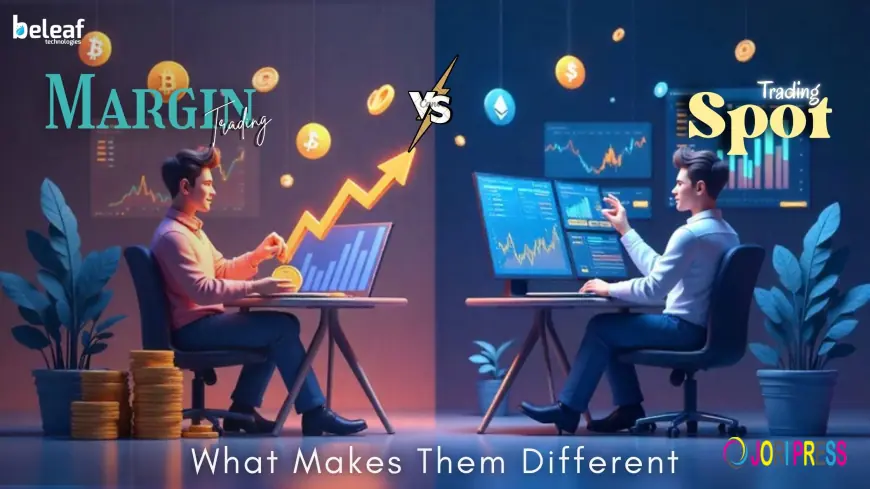Spot Trading vs. Margin Trading: Pros, Cons, and What Sets Them Apart

Table of Contents
-
Introduction
-
What is Spot Trading?
-
What is Margin Trading?
-
Pros and Cons of Spot Trading
-
Pros and Cons of Margin Trading
-
Key Differences Between the Two
-
Which Trading Style Fits You Best?
-
Why Spot Trading is the Best Choice for Most Traders
-
Spot Trading vs. Margin Trading: Common Misconceptions
-
Conclusion
Introduction
Cryptocurrency trading is full of opportunities, but choosing the right trading style can make all the difference. Two of the most common methods are spot trading and margin trading. While both involve buying and selling digital assets, they operate in very different ways. Spot trading is often seen as the simpler option, while margin trading appeals to those seeking greater rewards with higher risks. In this guide, we’ll walk you through what each method means, their pros and cons, and the key differences to help you decide which approach fits your trading style best.
What is Spot Trading?
Spot trading allows you to buy crypto instantly at market value and hold it as your own. In simple terms, you buy an asset like Bitcoin, Ethereum, or any other token at its current market price, known as the “spot price.” Once purchased, you own the asset directly and can store it in your digital wallet.
For example, if Bitcoin is trading at $28,000 and you buy one Bitcoin, it’s yours. You can hold onto it for weeks, months, or even years until you feel the time is right to sell. The profit comes from the difference between your buying price and selling price.
Spot trading is favored by beginners because it’s simple, transparent, and doesn’t require borrowing money. You can only lose the amount you invest, making it far less stressful compared to leveraged trades.
What is Margin Trading?
Margin trading requires a deeper understanding, making it less straightforward. Instead of trading only with the money you have, margin trading allows you to borrow funds from an exchange to increase your buying power. This is called “leverage.”
For instance, if you have $1,000 and use 5x leverage, you can trade as if you had $5,000. If the market moves in your favor, your profits are multiplied by five. But here’s the catch: if the market moves against you, your losses are also multiplied. In extreme cases, you can even lose more than your original investment.
Margin trading is popular with experienced traders who want to maximize short-term opportunities. However, it requires discipline, a good understanding of risk management, and the ability to handle market volatility.
Pros and Cons of Spot Trading
Pros:
-
Simple and beginner-friendly
-
You own the asset directly
-
Low-risk compared to leveraged trading
-
No borrowing fees or interest
-
Ideal for long-term wealth building
Cons:
-
Slower short-term profits compared to margin trading
Spot trading is all about steady progress. While it may not deliver instant results, it provides a clear, reliable path toward long-term gains, making it ideal for traders who value consistency over risky speculation.
Pros and Cons of Margin Trading
Pros:
-
Opportunity to earn higher profits using leverage
-
Can profit from both rising and falling markets
-
Allows for more diverse trading strategies
Cons:
-
Higher risk of losing money quickly
-
Borrowing comes with fees and interest
-
Requires constant monitoring of markets
-
Not suitable for complete beginners
The appeal of margin trading is strong, but so are the dangers. It’s best suited for traders with experience and a solid strategy.
Key Differences Between the Two
The biggest difference between spot trading and margin trading is ownership and risk. In spot trading, the coins you buy are truly yours to hold or transfer. It’s yours to keep, transfer, or hold long-term. In margin trading, you’re essentially borrowing funds, which means you don’t fully own the asset, you're only trading on its price movements.
Another difference lies in risk and reward. Spot trading offers slower but safer returns, while margin trading can bring big profits but also larger losses. Time commitment is also different. Spot traders can afford to be patient, but margin traders need to watch the market closely, sometimes minute by minute.
Which Trading Style Fits You Best?
Whether you go for spot or margin trading largely depends on your objectives and comfort level. If you’re new to crypto, prefer a low-risk path, and want to build wealth gradually, spot trading is the better option. It’s simple, less stressful, and more sustainable in the long run. If you’re experienced, comfortable with risk, and have time to monitor the markets, margin trading might appeal to you. It offers the potential for larger profits, but only if you’re prepared for the possibility of losses too.
Why Spot Trading is the Best Choice for Most Traders
Spot trading suits almost every type of trader, whether you’re looking for short-term gains or long-term growth. Here’s why:
Complete Ownership and Safety – When you buy crypto through spot trading, the assets are fully yours. You have total control, and your investments are secure without the added risks of borrowed funds.
Ease of Use – Spot trading is simple and beginner-friendly. There’s no need to deal with leverage, complex borrowing, or constant monitoring, making it easy to start trading right away.
Long-Term Growth – By holding your assets over months or years, you can benefit from the market’s upward trends and steadily grow your portfolio.
Short-Term Opportunities – You can use spot trading to benefit from short-term changes in crypto prices. You can buy and sell strategically to capture quick gains without the high risk associated with margin trading.
Freedom and Flexibility – You control when to buy, hold, or sell your crypto, giving you the flexibility to balance short-term trades with long-term investment strategies.
Modern platforms offer advanced spot trading crypto exchange features, such as secure wallets, real-time market data, and simple trade execution tools. These features make it easy to manage both short-term and long-term strategies confidently, helping traders grow their portfolios safely and efficiently.
Spot Trading vs. Margin Trading: Common Misconceptions
“Margin trading always makes more money.”
Not true. Although leverage can increase your gains, it can also intensify your losses. Many traders lose funds faster with margin trading.
“Spot trading is too slow to be worthwhile.”
False. Spot trading may seem slower, but it’s a reliable way to grow wealth without exposing yourself to unnecessary risks.
“Only experts can trade on margin.”
While it’s true that margin trading is best for experienced traders, beginners can learn step by step. However, it’s safer to start with very small amounts and never risk money you can’t afford to lose.
Conclusion
Both spot and margin trading play important roles in the crypto ecosystem. Spot trading is best for steady, long-term investing, while margin trading is aimed at those prepared to embrace short-term challenges for bigger potential rewards. to take on greater risk.
The best choice depends on your trading style, goals, and tolerance for risk. Beginners often start with spot trading, while advanced traders explore margin trading once they’ve built experience.
For businesses and developers looking to enter the crypto industry, it’s important to provide traders with the right tools. Modern platforms now include advanced spot trading crypto exchange features, such as real-time charts, secure wallets, and automated order systems, all designed to make trading more efficient. By building platforms with these tools, traders can explore both methods confidently.
At the heart of this progress is Spot Trading Crypto Exchange Development, which empowers businesses to create secure, user-friendly, and innovative platforms. By offering traders the choice between spot and margin trading in a safe environment, these exchanges can help users find the strategy that best fits their needs.
What's Your Reaction?
 Like
0
Like
0
 Dislike
0
Dislike
0
 Love
0
Love
0
 Funny
0
Funny
0
 Angry
0
Angry
0
 Sad
0
Sad
0
 Wow
0
Wow
0














































